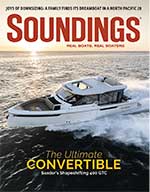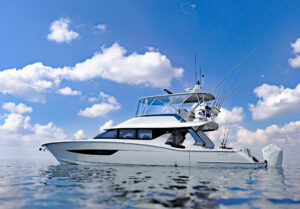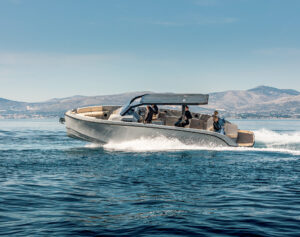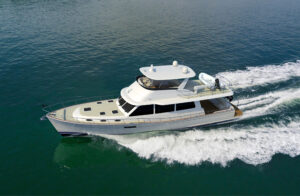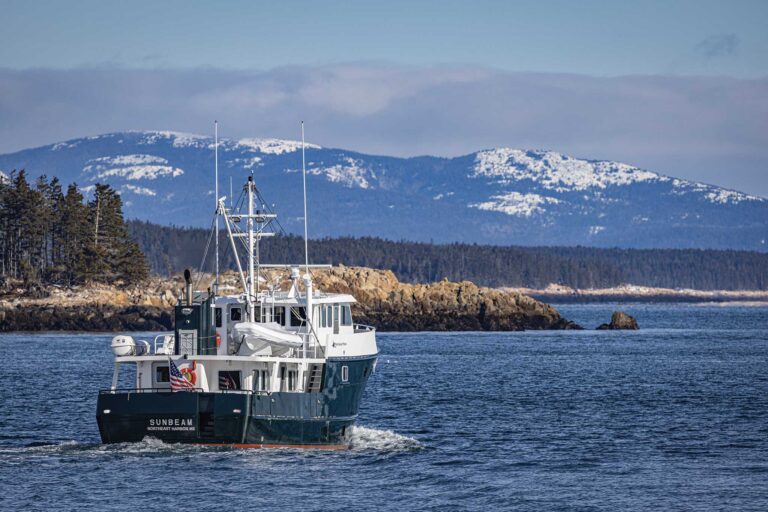
For Chuck Fadely and Helene Harris, it all started with a little sailboat. “I had a 22-foot, bilge-keel Westerly Nomad while living on the North Shore of Long Island,” says Fadely, a retired photojournalist. “It was named One Love. Helene and I had our first date onboard. In the four years since, we’ve never been apart.”
About two years ago, the couple started making plans to retire, sell their house and move onto a larger boat. But first, they had to find the right vessel. Fadely had owned a number of sailboats in the past—including a Siren 17, Catalina 22, Bristol 27 and Allmand 31—so he was able to quickly come up with a list of basic criteria. “We were looking for a budget-friendly, cruising sailboat priced around $20,000,” he says. “I knew about the Pearson yard in Rhode Island because I had owned a Bristol and was familiar with the company’s reputation for quality glass layup and decent build quality.”
The couple found just what they wanted in a 1979 Pearson 365 sloop, which they located at a boat yard in western Connecticut. When they made the purchase, romance played a part—the couple bought the boat on their honeymoon. “We were on the way to Maine for a week aboard the schooner Lewis R. French in Camden,” Fadely says.
The boat was in fair shape when they found it. “She looked good for the most part,” Fadely says. “The canvas was decent, the roller furling jib and the mainsail were both good and a surveyor had found no significant problems.” Still, to prepare the boat for living aboard they had to make some repairs, upgrades and installations. The list included rebuilding the V-drive; replacing the windlass and chain; replacing the muffler and heat exchanger; installing a water heater, a cabin heater, solar panels and dinghy davits; stripping the bottom and applying a barrier coat and paint. “We did almost all the work ourselves,” Fadely says.
The couple realized their efforts were worth it on the day they left their home waters of Long Island Sound. “It was exciting to go through Hell Gate at slack, then down the East River into New York City, past the hospital where Helene’s daughter was born, then past the rush hour helicopters ferrying stock brokers to Wall Street in Lower Manhattan,” Fadely says.
LOA: 36’ 7” / Beam: 11’4” / Displ.: 17,700 lbs. / Ballast: 7,000 lbs. / Fuel: 50 gals. / Water: 150 gals. / Power (aux.): 40-hp Westerbeke diesel
Fadely and Harris moved aboard in July 2017 and are now enjoying a big adventure. In late December, they were cruising down the Intracoastal Waterway and had plans to go onto the Bahamas and the Caribbean. The couple says the Pearson 365 is ideal for this type of cruising. At 36 feet, it’s sized right for them to manage easily, it has a shallow draft (4’5”), carries 150 gallons of water and has a 49-foot mast for clearing under bridges.
“It doesn’t have a lot of sail area, so she’s happy in 15 knots of wind on the beam,” Fadely says. “When we first got the boat, we were out with family aboard in Long Island Sound. The wind built suddenly to over 25 knots, and I was very nervous as my previous boats became unruly beasts at that wind speed. The Pearson, with full main and jib flying, handled it with no problem until I could reef down.”
That early experience gave him confidence in the boat.
“She’s pretty comfortable in rough water,” he says. “We came out onto Pamlico Sound in North Carolina into a 20-knot, wind-against-tide situation with big, short steep waves and she sailed pretty easily through the chop,” Fadely says. “The motion is easy, but as with every monohull, waves on the beam make her roll a little. The shallow draft has been great in the areas that haven’t been dredged in years.”

Auxiliary power comes from a 40-hp Westerbeke diesel, “a slow-revving and noisy but reliable old beast,” as Fadely calls it. Electronics include a Raymarine C70 suite with chartplotter, depthsounder and radar. Fadely uses a tablet with Navionics charts for navigation.
“We’ve been very happy with her so far,” Fadely says. “Laura Jack is small enough to handle solo but big enough to live on. She’s comfortable under sail and at anchor. Naval architect Bill Shaw designed the boat to be what he considered a proper craft for himself. It has traditional lines, a nice sheer and compromises in all the right places.”
WALKTHROUGH
The Pearson 365 sloop version carries around 570 square feet of sail (323 for the main, 247 for the jib) on a masthead rig. The hull has a skeg-hung rudder and a shallow-draft fin keel. Outside, lead ballast is just over 7,000 pounds. Hull construction is hand-laid fiberglass.
The 365’s profile is traditional, showing a straight bow and transom, with a modest, even sheer. The trunk cabin has four side ports and there’s a protective coaming around the 8-foot-long cockpit. Down below, there’s a V-berth in the forepeak with an adjacent enclosed head compartment to starboard. The main cabin has a folding table with bench seats—one converts to a berth. The U-shaped galley is at the foot of the companionway to port and is equipped with a sink, a three-burner stove and a refrigerator. Opposite is the nav station with a chart table and stowage. Auxiliary power was originally a 51-hp Perkins 4-108 diesel; 40-hp Westerbeke engines are popular alternatives today.
This article originally appeared in the March 2019 issue.

